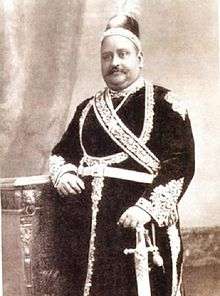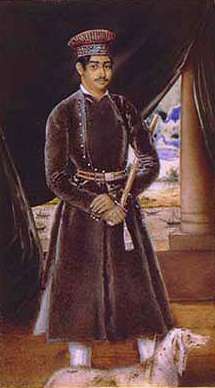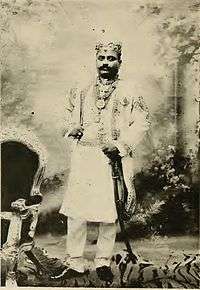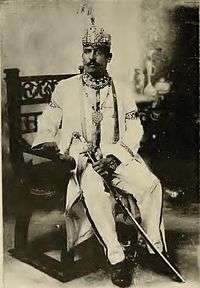Zamindar

A zamindar in the Indian subcontinent was an aristocrat similar to a lord of the manor or a baron. The term means "land owner" in Persian. Typically hereditary, zamindars held enormous tracts of land and control over their peasants, from whom they reserved the right to collect tax on behalf of imperial courts or for military purposes. Their families carried surnames of lordship, such as Chowdhury, Khan, Sardar, Malik, Thakur, Wadero, Reddy and Naidu. In the 19th and 20th centuries, many wealthy and influential zamindars were bestowed with princely and royal titles such as Maharaja (Great King), Raja (King) and Nawab (Prince).
During the Mughal Empire, zamindars belonged to the nobility[1] and formed the ruling class. Emperor Akbar granted them mansabs and their ancestral domains were treated as jagirs.[2] Under British colonial rule in India, the permanent settlement consolidated what became known as the zamindari system. The British rewarded supportive zamindars by recognizing them as princes. Many of the region's princely states were pre-colonial zamindar holdings elevated to a greater protocol. However, the British also reduced the land holdings of many pre-colonial aristocrats, demoting their status to a zamindar from previously higher ranks of nobility.
The system was abolished during land reforms in East Bengal (Bangladesh) in 1950,[3] India in 1951[4] and West Pakistan in 1959.[5]
The zamindars often played an important role in the regional histories of the subcontinent. One of the most notable examples is the 16th century confederation formed by 12 zamindars in the Bhati region, which, according to the Jesuits and Ralph Fitch, earned a reputation for successively repelling Mughal invasions through naval battles. The confederation was led by a zamindar-king, Isa Khan, and included both Muslims and Hindus, such as Pratapaditya. The zamindars were also patrons of the arts. The Tagore family produced India's first Nobel laureate in literature in 1913, Rabindranath Tagore, who was often based at his estate. The zamindars also promoted neoclassical and Indo-Saracenic architecture.
Mughal era

Before Mughal rule in India, the aristocracy collected and retained revenue from land and production. The Mughals appointed people to act as tax officers, sending them around the country to oversee collection of revenue and remit it to the capital city of Delhi.[6] These people were known as the zamindari (intermediaries)[7] and they collected revenue primarily from the Ryots (peasants)[8] The zamindari system was more prevalent in the north of India because Mughal influence in the south was less apparent.[7]
The zamindari system ensured proper collection of taxes in a period when the power and influence of the Mughal emperors were in decline. With the Mughal conquest of Bengal, "zamindar" became a generic title embracing people with different kinds of landholdings, rights and responsibilities ranging from the autonomous or semi-independent chieftains to the peasant-proprietors. All categories of zamindars under the Mughals were required to perform certain police, judicial and military duties. Zamindars under the Mughals were, in fact, more the public functionaries than revenue collecting agents. Although zamindaris were allowed to be held hereditarily, the holders were not considered to be the proprietors of their estates.[9]
The territorial zamindars had judicial powers also. This conferred status with attendant power, which really made them the lords of their domains. They held regular courts, called zamindari adalat. The courts gave them not only power and status but some income as well by way of fines, presents and perquisites. The petty zamindars had some share in the dispensation of civil and criminal justice. The Chowdhurys, who were zamindars in most cases, had authority to deal with the complaints of debts, thefts and petty quarrels and to impose paltry fines.
British era
The British colonists of India generally adopted the extant zamindari system of revenue collection in the north of the country. They recognised the zamindars as landowners and in return required them to collect taxes. Although some zamindars were present in the south, they were not so in large numbers and the British administrators used the ryotwari (cultivator) method of collection, which involved selecting certain farmers as being land owners and requiring them to remit their taxes directly.[7]
History
Some new zamindars were old Rajas. Many descended from 18th century revenue speculators and military adventurers. Several families were of very ancient lineage, like those claiming Bargujar, Meenas ancestry and had always been independent rulers at earlier periods of Indian history. They frequently intermarried with the ruling families of the princely states such as Sita Devi of Baroda's marriage (daughter of Rao Venkata Kumara Mahipati Surya Rau, the Zamindar of Pithapuram), to Maharaja Pratap Singh Gaekwad of Baroda. Their tenants numbered from dozens to many thousands and, under imperial law, had to pay rent to zamindars to retain rights to their land.
Accession
Unlike the autonomous or frontier chiefs, the hereditary status of the zamindar class was circumscribed by the Mughals, and the heir depended to a certain extent on the pleasure of the sovereign.[10] Heirs were set by descent or a times even adoption by religious laws.[11] Under the British Empire, the zamindars were to be subordinate to the crown and not act as hereditary lords, but at times family politics was at the heart of naming an heir.[12] At times, a cousin could be named an heir with closer family relatives present;[13] a lawfully wedded wife could inherit the zamindari if the ruling zamindar named her as an heir.[14][15]
Southern India

The governors of the Vijayanagara Empire, who were under the direct control of central government, ruled the provinces and feudatory kings. The feudatory kings were called “Nayakas” and paid tribute to the emperor who ruled the kingdoms. The Vijayanagara Empire was destroyed in the Tallikota war of 1565 AD, when Muslim states (Golconda, Bijapur, Ahmednagar, and Bidar) came together against the empire. Tributary kingdoms that were under Vijayanagara Empire came under the control of Sultans of Golconda and Bijapur. These Golconda and Bijapur Sultans employed subservient people from Balija, Reddy, Kamma and Velama shudras castes as kings (instead of the Kshatriya kings whom they perceived as a threat, due to their royal lineage & ambitious tendencies to fight for rule) as the rulers of kingdoms and had them to pay the tribute and collected revenue. Thus many more of these kingdoms/provinces, also known as Samsthanams or Zamindaris, came into being.
The Golconda Empire came under the control of the Mughal Dynasty in 1686 and became to be known as the Deccan Suba. The rule of the Mughal Dynasty didn’t last long. Nizamul Ul Mulk Asaf Jah, as the governor of the Deccan, controlled the present state of Andhra Pradesh and parts of Maharashtra and Karnataka. In the beginning the French had influence over Hyderabad. However, Salabat Jang, who came to power after his father, realized that the French were losing ground to British and so realigned himself with the English. In 1761, the East India Company helped Nizam Ali Khan to depose his brother Salabat Jang and helped him occupy the Deccan Suba. The East India Company then took Andhra regions for lease from Nizam Ali. Later, by accords of 1768 and 1779 these Andhra regions came under complete control of East India Company, whereas Telangana states remained under Nizam. In 1802, the British government under a Permanent Revenue Settlement agreement restored the ruling powers and rights of kings of Andhra regions. During this time, rich and influential people became rulers (zamindars) to the city-states (zamindaris). In the beginning, the British allowed old kingdoms to have armies with the condition that they would support the British Empire during the war. However, this right was abolished and these kings were reduced to the level of zamindars. These feudal kingdoms/zamindaris were abolished after the formation of the Indian Union, a democratic republic.

 Rajha Inuganty Narayana Rao, zamindar of Vavilavalasa
Rajha Inuganty Narayana Rao, zamindar of Vavilavalasa

After creation of India
In most states the zamindari system was mostly abolished in India soon after its creation with the first amendment to the constitution of India which amended the right to property as shown in Articles 19 and 31.[16] This allowed the states to make their own "Zamindari Abolition Acts". The term is usually associated with the aristocracy as zamindars are considered to be of the landed gentry. Zamindars tend to marry into families of the same social class; however, there have been cases of impoverished nobles marrying into rich families with no titles (this is sometimes considered marrying into the same social class, even if the other family is not of the nobility).
After independence of Bangladesh

The Zamindars of Bengal were influential in the development of Bengal. They played pivotal part during the Indian Rebellion of 1857.[17] In 1950, land reform was accomplished in East Bengal with the abolishment of the feudal zamindari system. The abolition of the zamindari system (which divided the society into lords, owners of property, and commoners, users of property) in Bangladesh after independence from Pakistan was a major landmark that took place immediately effective January 10, 1972 under a Presidential Ordinance, which became permanent under its new constitution April 10, 1973.
See also
References
- ↑ Metcalf, Barbara Daly (1984). Moral conduct and authority: the place of adab in South Asian Islam. University of California Press. p. 269.
- ↑ An account of the Ruling Classes of Mughal Empire
- ↑ Baxter, C (1997). Bangladesh, from a Nation to a State. Page 72. Westview Press. ISBN 0-8133-3632-5. OCLC 47885632.
- ↑ http://www.gktoday.in/blog/abolition-of-zamindari-in-india/
- ↑ http://www.dawn.com/news/570487
- ↑ Hansen, Valerie; Curtis, Kenneth R. "The Politics of Empire in Southern and Eastern Asia". Voyages in World History, Volume 2: Since 1500. p. 461.
- 1 2 3 Jaffrelot, Christophe (September–October 2000). "Sanskritization vs. Ethnicization in India: Changing Indentities and Caste Politics before Mandal". Asian Survey. 40 (5): 756–766. doi:10.1525/as.2000.40.5.01p0100d. JSTOR 3021175.
- ↑ Habib, Irfan (2000) [1963]. The Agrarian System of Mughal India, 1526-1707 (2nd revised ed.). Oxford University Press. ISBN 0-19-562329-0. For the meanings of zamindar see pp. 140ff.
- ↑ "Mughal Society". History Tuition. Archived from the original on October 17, 2011.
- ↑ Islam, Sirajul; Akhter, Shirin (2012). "Zamindar". In Islam, Sirajul; Jamal, Ahmed A. Banglapedia: National Encyclopedia of Bangladesh (Second ed.). Asiatic Society of Bangladesh.
- ↑ The Indian Law Reports: Madras series. Controller of Stationery and Print. 1888. p. 385.
- ↑ McLane, John R. (2002). Land and Local Kingship in Eighteenth-Century Bengal. Cambridge University Press. p. 223. ISBN 978-0-521-52654-8.
- ↑ Madras High Court Reports: 1870 and 1871. J. Higgingbotham. 1872. p. 209.
- ↑ Great Britain. Privy Council. Judicial Committee.; India. Courts. (1908). "Kashi Prasad v. Indar Kunwar". Allahabad Law Journal. Indian Press. 5: 596.
- ↑ Woodman, Joseph Vere; Monnier, Emile Henry (1902). A Digest of Indian Law Cases: Containing High Court Reports, 1862-1900, and Privy Council Reports of Appeals from India, 1836-1900, with an Index of Cases. Volume III: J-M. Superintendent of Government Printing, India. p. 5498.
- ↑ Guha, Ramachandra (2011). India After Gandhi. Ecco. pp. 219–220. ISBN 978-0-330-54020-9.
- ↑ Patriotic and Comprador Zamindars in the Great Rebellion of 1857